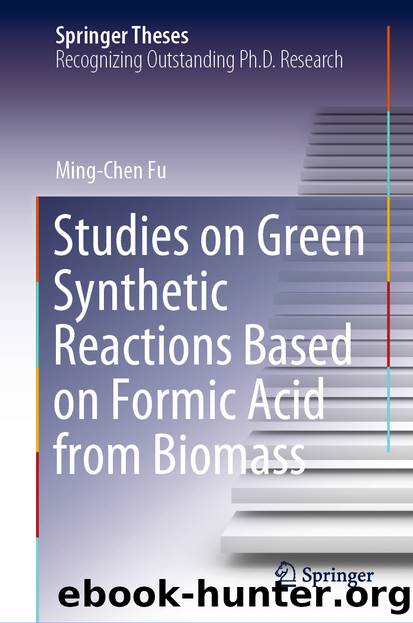Studies on Green Synthetic Reactions Based on Formic Acid from Biomass by Ming-Chen Fu

Author:Ming-Chen Fu
Language: eng
Format: epub
ISBN: 9789811576232
Publisher: Springer Singapore
Then, for the unsymmetrical alkynes, as shown in Table 3.4, such as aryl alkyl alkynes, the hydrocarboxylation affords the α-arylated alkenyl carboxylic acids as the major product. Dppen was chosen as the ligand because of its slightly better performance than dppbz. When 1-phenylpropyne was used as the substrate, the hydrocarboxylation product was obtained in as high as 97% yield, in which the α-carboxylated product is the major isomer (α/β = 1.9/1). This result reveals that in the hydrometallation step, nickel prefers the α-position of the aryl substituent. In addition, the ratio of the two regioisomers (α/β) is also affected by the steric effect of the alkyl substituent of the alkyne. Compared with product 2a, when 1-phenylbutyne was used as substrate, the reaction gave excellent yield with a higher ratio of the two isomers (93% yield, α/β = 4.6/1). When using hex-1-yn-1-ylbenzene as a substrate, the yield of the hydrocarboxylated product (2c) was obtained with a slightly reduced yield and no further improvement in regioselectivity. These results suggested that the electronic effect on the aryl substituents slightly affects the yield but has no major effect on the regioselectivity. Although several investigators reported that heterocyclic substituted alkynes can considerably improve the regioselectivity of hydrometallization [14], unfortunately, in our study, no matter whether the heterocyclic substituted alkyne or alkyl chain contained heteroatoms, the regioselectivity of hydrocarboxylated products was not improved substantially (2f, 2g). When the alkyne was substituted with a secondary alkyl group (2h), the α/β regioselectivity further increased, but with a decrease of the yield (57%, α/β = 6.1/1) due to steric hindrance. When (3-(benzyloxy)but-1-yn-1-yl)benzene was applied, good regioselectivity was achieved with moderate yield (2i, 68%, α/β = 90/10). Using 4,4-dimethyl-2-pentyne as the substrate, the carboxylation site was completely selected at the position with less steric hindrance in excellent yield (2j, 98%, α/β = 0/100). From the results described above, it can be seen that the carboxylation takes place selectively on the α-position of the aryl substituent, and the steric hindrance effect of the alkyl substituent acts as an additional factor to determine the regioselectivity. For unsymmetrical alkyl-alkyl-substituted acetylenes, the steric effects act as the dominant factor.Table 3.4Scope and selectivity of unsymmetrical internal alkynes
Download
This site does not store any files on its server. We only index and link to content provided by other sites. Please contact the content providers to delete copyright contents if any and email us, we'll remove relevant links or contents immediately.
The Complete Stick Figure Physics Tutorials by Allen Sarah(7267)
Secrets of Antigravity Propulsion: Tesla, UFOs, and Classified Aerospace Technology by Ph.D. Paul A. Laviolette(5239)
Thing Explainer by Randall Munroe(3850)
The River of Consciousness by Oliver Sacks(3499)
The Order of Time by Carlo Rovelli(3098)
How To by Randall Munroe(2972)
A Brief History of Time by Stephen Hawking(2913)
I Live in the Future & Here's How It Works by Nick Bilton(2901)
The Great Unknown by Marcus du Sautoy(2616)
What If?: Serious Scientific Answers to Absurd Hypothetical Questions by Randall Munroe(2591)
Midnight in Chernobyl by Adam Higginbotham(2434)
Blockchain: Ultimate Step By Step Guide To Understanding Blockchain Technology, Bitcoin Creation, and the future of Money (Novice to Expert) by Keizer Söze(2411)
Networks: An Introduction by Newman Mark(2306)
The Meaning of it All by Richard Feynman(2269)
Easy Electronics by Charles Platt(2253)
The Tao of Physics by Fritjof Capra(2205)
Midnight in Chernobyl: The Untold Story of the World's Greatest Nuclear Disaster by Adam Higginbotham(2129)
When by Daniel H Pink(2058)
Introducing Relativity by Bruce Bassett(2050)
